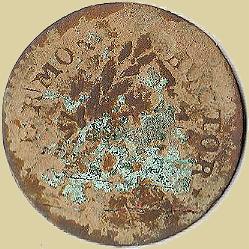
Dirt Fishing is my latest obsession. O is not treasure hunting.
Letterboxing is simulated treasure hunting. Dirt fishing is the real thing.
Dirt fishing is treasure hunting with a metal detector.
The research is real, not contrived. There is no guarantee
of success, no one to whine at or pump for clues, and no
competition, except a true one with the past and the mix
of trash and treasure below your feet.
Your research and skill with the machine either leads you to
actual treasure, or it doesn't. There is no one to ask if
it has "gone missing". No websites to check how many have
found it before you. You may be the first to see it in
over 200 years. I have been.

I do it for my love of history. I like discovering pieces of
the past both in research, and in the field. I like thinking
about -- why is this here? What was here before? Who lived
here? What was life like? I also like discovering where people
were in the past that few know about.
I suck at it. Which is good in a way, as there is alot of
room for growth. I have, however, had a few good finds. My
best is a Vermont Copper from 1787, pictured on this page.
They didn't make all that many of these in the Republic of
Vermont, before it became a state. I've also found a silver
Spanish half-reale from the 1700s and a big handful of large
coppers, which presents quite a mystery to me (due to their
location and density), something I
intend to research and write a paper on someday.
These George II and III halfpennies, as well as state-produced
colonial coppers, circulated in the 18th century, before
there was federally minted coinage. Some are counterfeit,
some are real (counterfeits are also of 18th century vintage,
and were common).
